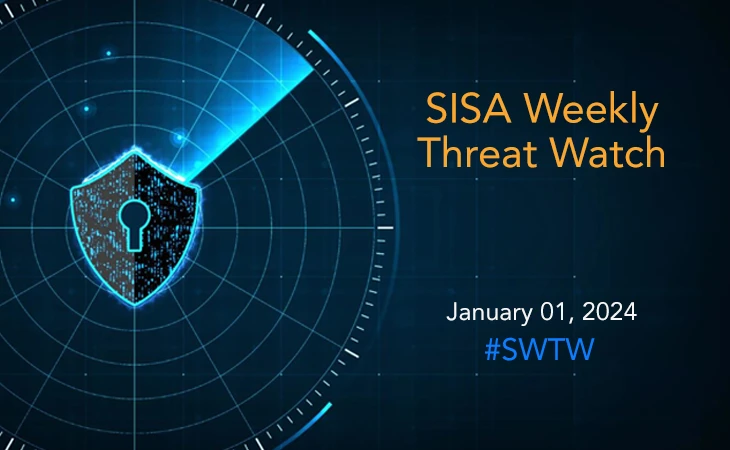Exclusive Insights
- The Critical Role of Managed Compliance in the Evolving Digital Payments Landscape
- The Rise of AI: A New Era in Cybersecurity Resilience
- Redefining Cybersecurity in a Fragmented Landscape: The Case for MXDR
- Cybersecurity Predictions and Trends for 2024
- Securing Tomorrow: Asia’s Digital Payment Transformation and the Road to 2024
- An American healthcare MNC strengthened its data security policy by integrating SISA Radar with DLP solutions
- SISA’s forensics-driven MDR solution helps Club Prophet improve monitoring of workloads on Google Cloud Platform
- SISA ProACT’s cloud-based MDR solution helps neobank improve real-time threat detection and response
- SISA helps a global cloud-based solutions provider mitigate IoT device vulnerabilities
Knowledge Lounge » Securing Tomorrow: Asia’s Digital Payment Transformation and the Road to 2024
Securing Tomorrow: Asia's Digital Payment Transformation and the Road to 2024
Share on

As we witness the dawn of a new era in the global financial landscape, Asia emerges as the epicenter of a digital payments revolution, reshaping not just regional economies but also setting new benchmarks for the world. Consider this: India alone accounted for 46% of global real-time transactions in 2022 (1), a staggering statistic by any measure. Meanwhile, countries like Thailand, South Korea, and Malaysia are not far behind, with their per capita transaction rates painting a picture of societies rapidly moving towards cashless economies. This transformation, powered by rapid technological advancements and changing consumer preferences, is not just a narrative of growth but a testament to Asia’s ability to lead and innovate in the digital age.
The heart of this massive change? Innovations like mobile wallets, contactless payments, and QR-based systems, to name a few. The Asian market has been a fertile ground for experimentation and adoption of technologies like Unified QR codes, as seen in Singapore’s PayNow and Thailand’s PromptPay.
Another significant development in this landscape is the emergence of Central Bank Digital Currencies (CBDCs). With the digital Yuan already a reality in China and other countries exploring similar avenues, CBDCs are poised to redefine the very essence of money and transactions. Their potential to streamline cross-border payments and settlements is immense, presenting an opportunity to make financial systems more inclusive, efficient, and secure.
These newer ways to transact represent a cultural shift where people value convenience, security, and speed above all. With all these rapid changes, traditional financial institutions are racing to keep up. That’s where Payments-as-a-Service (PaaS) and API models come in, enabling legacy banks to offer new, fintech services without a complete overhaul. This collaboration is a perfect mix of the old and the new, essential for surviving in this fast-paced digital payment world.
The Price of Progress: Challenges in Asia’s Cashless Journey
As digital payments skyrocket in Asia, so does the risk of cyber threats, rendering the region a prime target for cybercriminals. This escalated risk is underscored by Asia-Pacific consistently maintaining its status as the most targeted globally, with 20.4% of all attacks in 2021 and a significant increase to 24.1% in 2022 (2).
The disparity in payment systems, where some nations are heavily reliant on cash while others rapidly adopt digital transactions, creates vulnerabilities within the overall financial ecosystem. Cybercriminals often exploit these variations and gaps in security protocols, targeting less secure or outdated payment infrastructures in regions that are slower to adapt to digital payment methods. Furthermore, the adoption of promising technologies like SoftPOS faces practical challenges due to infrastructure preferences and competition from enhanced Android Smart POS devices.
Additionally, it’s important to consider how the diverse compliance and regulatory structures shape the landscape. These rules and regulations have a significant impact on the profitability and operational dynamics of payment systems. For companies, this means navigating through a rather complex regulatory environment, which is a crucial part of managing secure digital payments effectively.
As Asia’s digital payments landscape continues to grow, it faces multifaceted challenges that demand strategic focus and innovative solutions to ensure its sustainable and secure development. Reflecting on the adage “With great power comes great responsibility,” it’s crucial for all key players in cybersecurity – including solution providers, regulators, customers, and other stakeholders – to collaborate in crafting robust solutions to tackle this worldwide challenge. This unified approach is vital for effectively addressing the complex and evolving threats in the digital realm. These multifaceted challenges require strategic attention and innovative solutions to ensure the sustainable growth of Asia’s digital payments landscape.
The Way Forward: Preparing for 2024
The path ahead is laden with challenges, primarily in the form of cybersecurity threats. With the rise in digital transactions, the playground for hackers has just gotten bigger. As 2024 approaches, the goal for cybersecurity in digital payments isn’t just to defend against threats but to make sure that financial transactions are safe, efficient, and innovative as the digital world keeps evolving.
Here are my 5 key takeaways:
1) Understanding and adapting to the diverse regulatory landscape is paramount; staying informed about changes and engaging with policymakers will ensure that security strategies are compliant and effective.
2) Investing in advanced security technologies and practices is critical — adopting multi-layered defense mechanisms and utilizing AI for real-time fraud detection.
3) Prioritizing preparedness for the emergence of next-generation technologies, notably CBDCs and evolving blockchain innovations, is essential. These technologies are on the brink of revolutionizing payment methods, making it imperative to comprehend and address their security implications to stay ahead in an increasingly digital financial landscape.
4) Spearheading consumer education initiatives about security best practices will enhance the overall security posture of the digital payments ecosystem.
5) And finally, as the focus continues to be on the development of new products and services, it’s essential for organizations to embed security as a foundational element. This preemptive security-first approach not only safeguards their innovations but also enhances overall user trust. Additionally, a focus on user-friendly and secure interfaces is crucial. Simplifying and securing user interactions minimizes the likelihood of human error, a common catalyst for security breaches. By prioritizing both ease of use and robust security, organizations can foster a safer and more efficient digital environment.
References:
Exclusive Insights
- The Critical Role of Managed Compliance in the Evolving Digital Payments Landscape
- The Rise of AI: A New Era in Cybersecurity Resilience
- Redefining Cybersecurity in a Fragmented Landscape: The Case for MXDR
- Cybersecurity Predictions and Trends for 2024
- Securing Tomorrow: Asia’s Digital Payment Transformation and the Road to 2024
- An American healthcare MNC strengthened its data security policy by integrating SISA Radar with DLP solutions
- SISA’s forensics-driven MDR solution helps Club Prophet improve monitoring of workloads on Google Cloud Platform
- SISA ProACT’s cloud-based MDR solution helps neobank improve real-time threat detection and response
- SISA helps a global cloud-based solutions provider mitigate IoT device vulnerabilities
 USA
USA India
India APAC
APAC Middle East
Middle East Rest of the Countries
Rest of the Countries

 Facebook
Facebook Linkedin
Linkedin  Youtube
Youtube






